Dark chocolate is a special type of chocolate that has a particularly high concentration of antioxidants and beneficial natural compounds from the cocoa bean.
It’s a useful food to add to your diet for better heart health, longevity, and resistance to chronic diseases.
The health benefits of dark chocolate might be a bit surprising, because chocolate is fairly high in sugar.
However, it turns out that on balance, the benefits of the antioxidants in dark chocolate outweigh the drawbacks of the sugar content at small to moderate daily doses.
If you want dark chocolate that’s both tasty and healthy, our researchers have ranked the highest-quality dark chocolates you can get.
Research
Rankings
1. Alter Eco Super Blackout
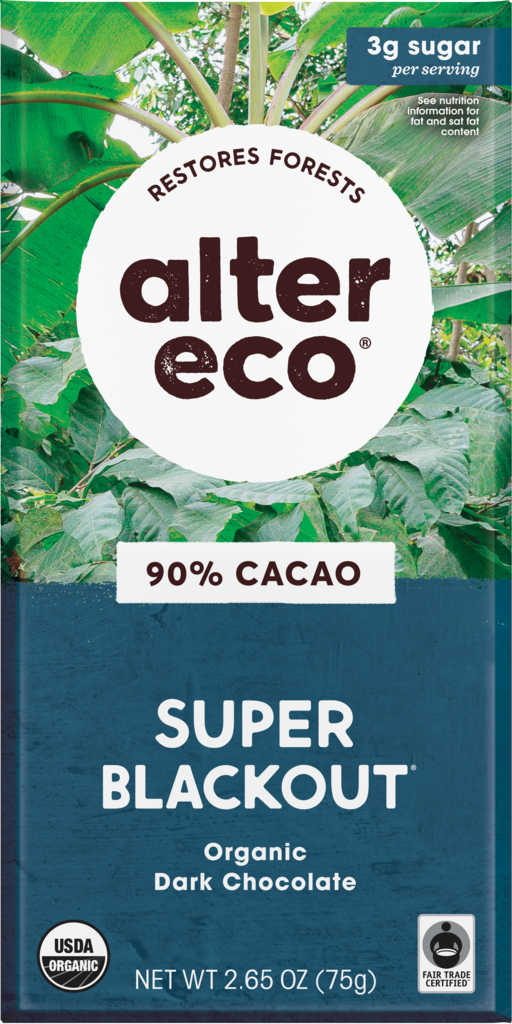
Alter Eco goes the extra mile to demonstrate that their product is high-quality—it’s certified both organic and fair-trade, and produced using a carbon-neutral manufacturing process.
On top of that, you get a wide range of varieties, ranging in cocoa content from 70% to 90% (our favorite, Super Blackout, is at the high end of this range). This versatility makes it a fantastic all-around choice if you’re looking for a great dark chocolate bar.
Add to that the fact that there are no extra flavorings or additives and you’ve got a winner.
2. Endangered Species Extra Dark Chocolate Panther
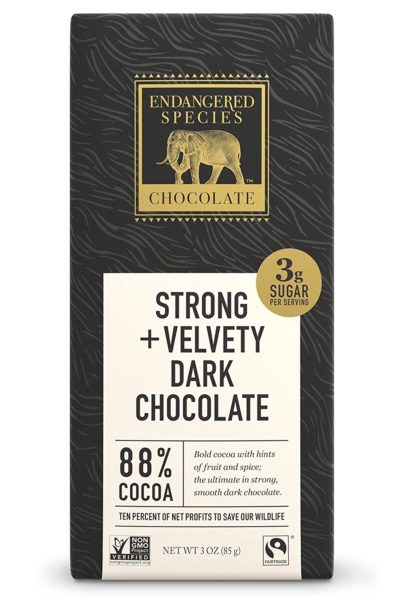
Endangered Species Chocolate has a social mission as well as a commercial one. Part of the profits from their sales go to protect endangered rainforest species, like this chocolate bar’s namesake, the panther.
But this chocolate isn’t just good for the rainforest—the 88% cocoa content makes it super high in antioxidants and fiber, and low in sugar.
3. Lindt Excellence Supreme Dark
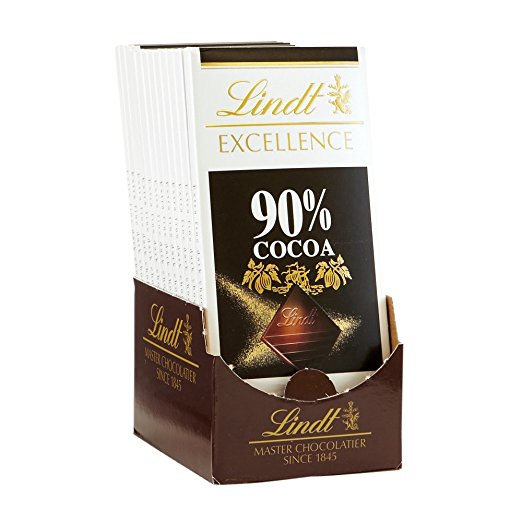
Lindt makes a fantastic super-dark chocolate bar that is 90% cocoa solids. Thanks to the presence of real vanilla beans, extracted with bourbon, its rich taste is complemented by the airy notes of vanilla oils.
The fiber content is high and the sugar content is low, making this a great choice if you want an extremely dark chocolate.
4. Lily’s Intensely Dark Chocolate
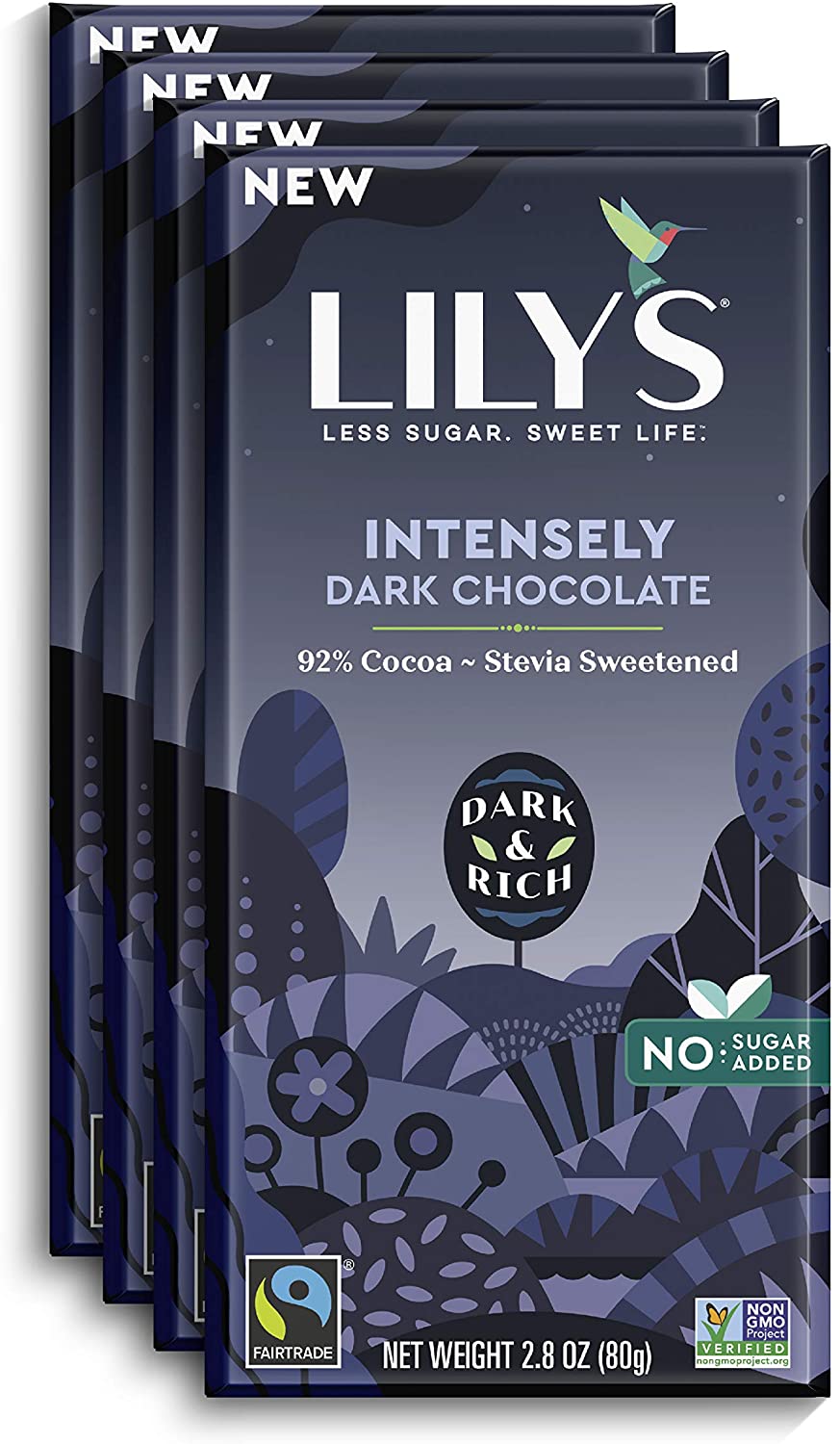
Lily’s Intensely Dark Chocolate is our favorite pick for people who are weight-conscious or who are concerned with their sugar intake. Instead of using sugar to offset the bitter taste of raw cocoa, Lily’s uses erythritol to keep the sugar content at zero.
Whether you’re a keto dieter looking for a treat that’s keto-friendly or a dieter looking to lose weight without forgoing the occasional chocolate, it’s a great low sugar option.
5. Pascha Very Dark Chocolate
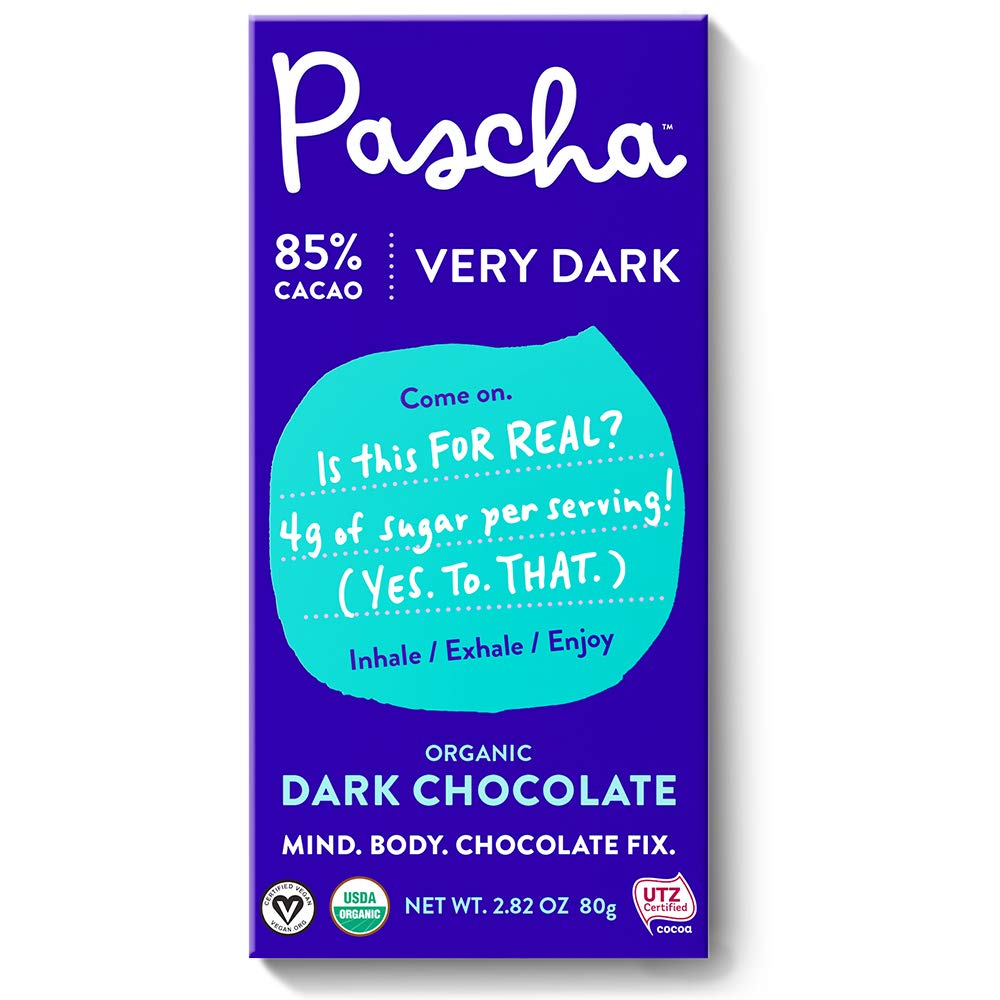
Pascha makes a dark chocolate bar that is both organic and ethically sourced. For organic fans, it’s a great choice, especially for those who want something a little smoother and less complex than the darkest of the dark chocolates. The cocoa content is high and the sugar content is low, making it a strong overall pick.
6. Ghirardelli Chocolate Intense Dark
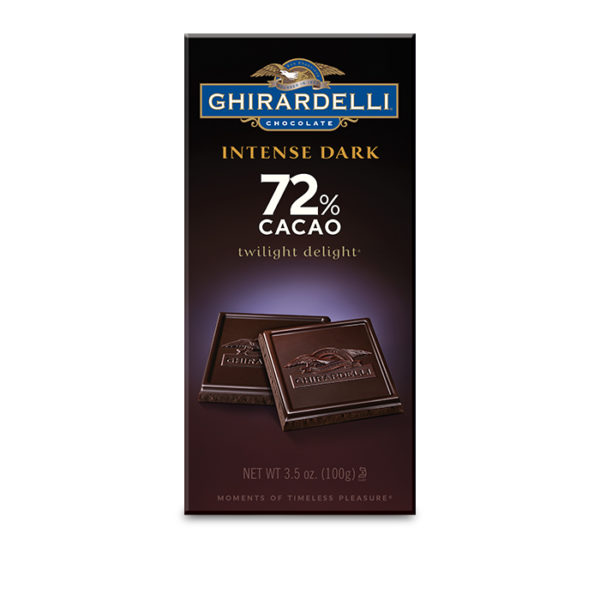
Ghirardelli makes an 72% cocoa dark chocolate bar that’s a bit more approachable for people who shy away from the bitter and complex taste of some of the more raw and natural dark chocolates.
Ghirardelli includes natural flavors and vanilla extract to smooth out some of the flavoring, and milk fat for more creaminess.
Using dairy does make this dark chocolate not a viable option for vegans or people with harsh lactose intolerance, so if you fit in these categories, you’ll want to look elsewhere.
7. Equal Exchange Total Eclipse
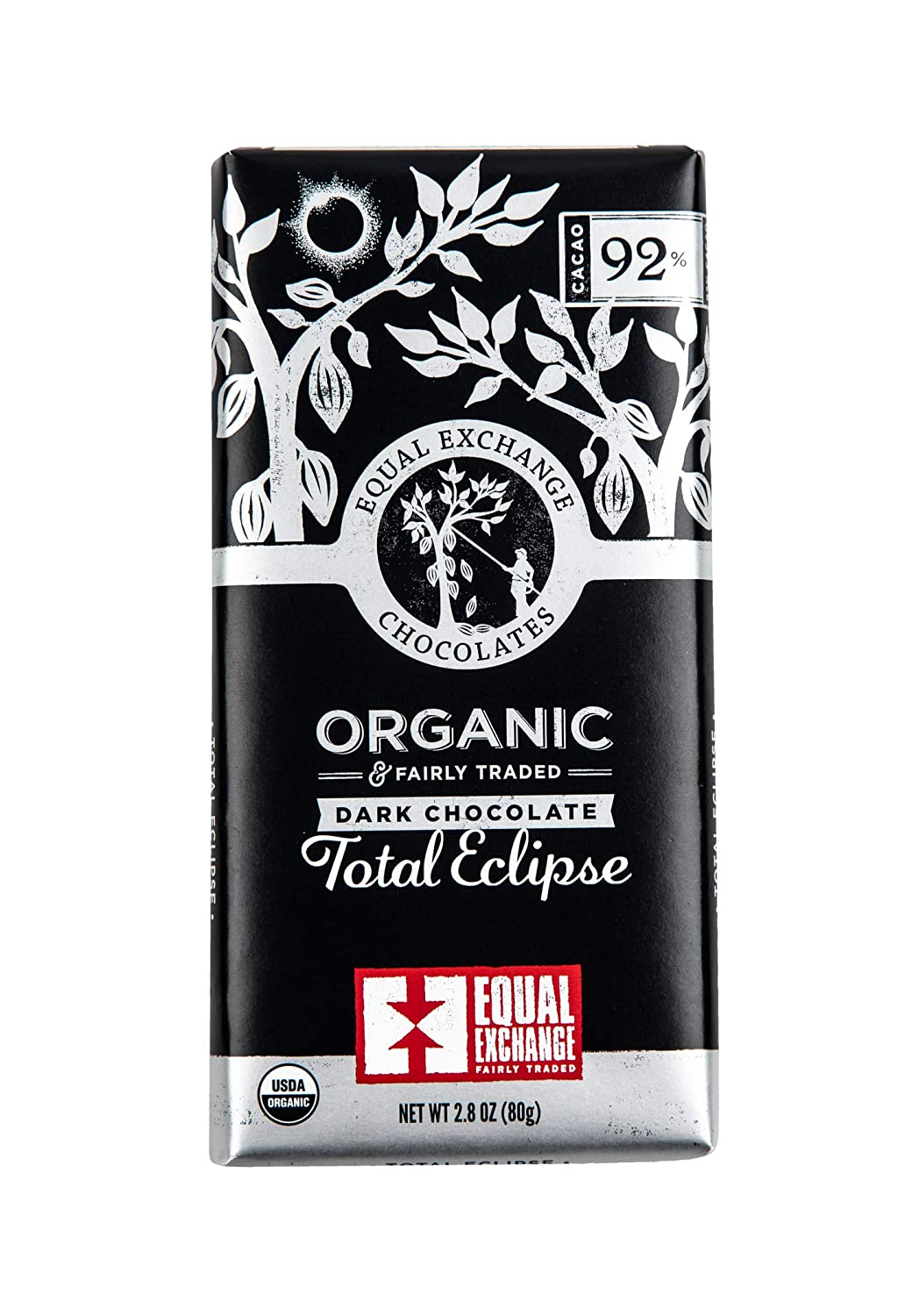
Equal Exchange puts a very high cocoa content into their darkest chocolate bar, pushing to cocoa content up to a shocking 92%. This makes it great for people who appreciate the complex, bittersweet taste of ultra-dark chocolate, though it may be a bit extreme for others.
8. GODIVA Chocolatier
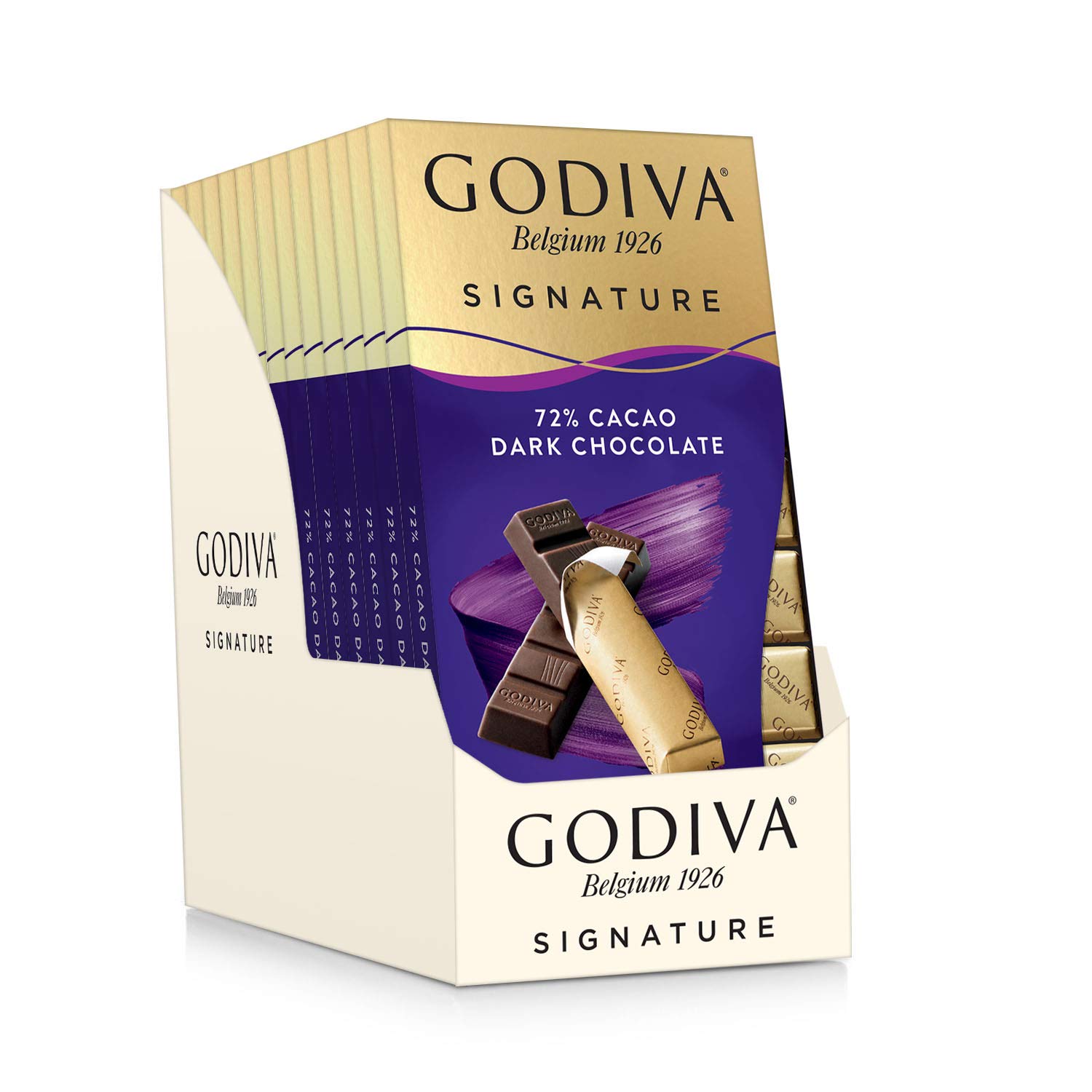
GODIVA Chocolatier makes 72% dark chocolate bars that are smoother and less intense than some of the higher cocoa content dark chocolates on the market.
It also has no dairy ingredients, which is not common among the lower cocoa content chocolates.
It’s a good choice for those who are dairy averse but also want something a little different than the extreme dark chocolates that have 80 or 90% cocoa. The only downside is that, as a result of the lower cocoa content, the sugar content is higher.
9. BIJA Chocolates Organic Dark Chocolate
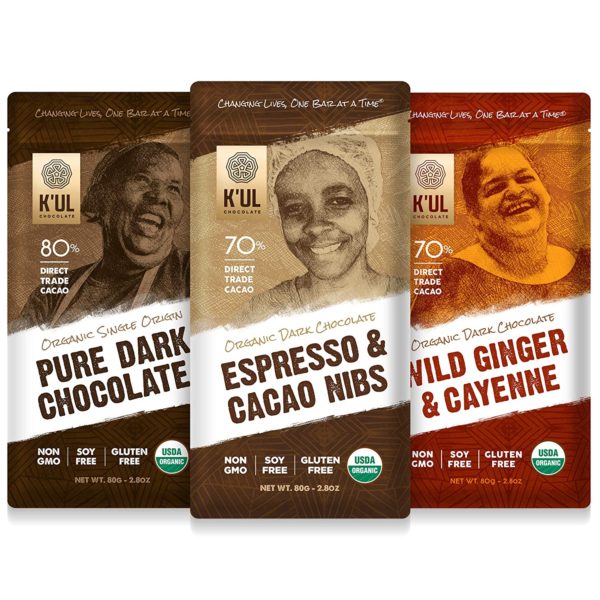
BIJA Chocolates Organic Dark Chocolate comes in three distinct flavors, all of which have 72% cocoa content and all of which are certified organic.
The flavors range from citrus and inca berry to espresso and cacao nibs to wild ginger and cayenne, so if you are tired of the same dark chocolate flavor, give BIJA a try.
Like other flavored dark chocolates, the extras do bump the sugar content up, so it’s better for occasional use, not daily use.
10. Green & Black’s Organic Dark Chocolate
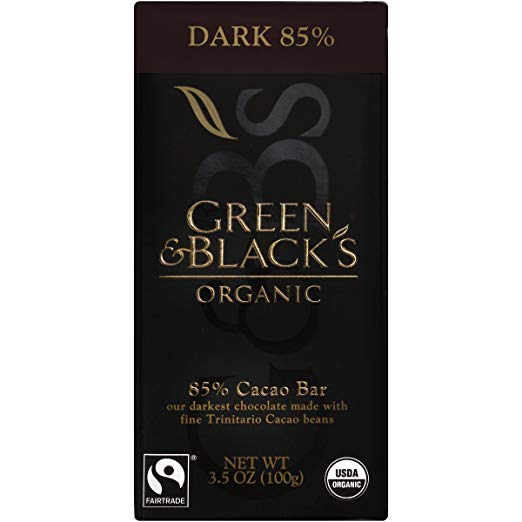
Green & Black’s Organic Dark Chocolate is a smooth and approachable dark chocolate that has 70% cocoa content and notes of vanilla bean, thanks to the organic vanilla extract used to make it.
All of the ingredients are certified organic, making it a good choice for those looking for a milder dark chocolate with minimal change of pesticide or synthetic fertilizer content.
Category winners
Best dark chocolate overall: Alter Eco Super Blackout
Alter Eco Super Blackout takes our top stop thanks to its simple formulation and rigorous commitment to purity. The “Super Blackout” variety, at 90% cocoa, is our recommendation, but this organically-certified dark chocolate comes in varieties with anywhere from 70%, 85%, and 90% cocoa, which further increases its versatility.
Best dark chocolate for baking: Lindt Excellence Bar
Lindt Excellence is 90% cocoa, providing a potent dose of the antioxidants in dark chocolate, while also keeping the other ingredients balanced enough to bake and melt well. For dark chocolate recipes, it’s our recommendation.
Best organic fair-trade dark chocolate: Alter Eco Super Blackout
Alter Eco takes enormous care to ensure their dark chocolate is produced as ethically as possible. They are certified organic, fair trade, and carbon neutral, which easily puts it at the top of our recommendations for ethically-produced dark chocolate.
Best dark chocolate for weight loss: Lily’s Intensely Dark Chocolate
Lily’s uses erythritol instead of sugar to add sweetness to their ultra-dark chocolate bar, which makes it great for people looking to lose weight. Keeping the sugar content low is one good way to enjoy chocolate while on a diet.
Best dark chocolate for melting: Lindt Excellence Bar
Lindt is careful to keep the cocoa content high but the other ingredients balanced just right to facilitate melting. For decoration or confectionery uses, it’s our go-to choice.
Best dark chocolate for the keto diet: Lily’s Intensely Dark Chocolate
The ultra-dark formulation (92% cocoa!) and use of erythritol instead of sugar for sweetness pushes the sugar content of these dark chocolate bars all the way to zero. For a keto-compatible chocolate bar, it’s the best way to go.
Who should buy dark chocolate?
Dark chocolate is safe for most individuals and is packed full of healthy fats and antioxidants to promote feelings of weed being. It also contains a good amount of healthy fat and some caffeine to promote feelings of satiety. However, its caloric density can offset the satiety, leading to unexpected weight gain when consumed in small doses.
Dark chocolate is generally safe for pregnant women and children in small doses. Diabetics will need to proceed with caution because some varieties of dark chocolate can contain a lot of sugar.
How we ranked
When choosing the best dark chocolate, the first thing we looked at was added sugars. Generally speaking, we preferred products with lower amounts of sugar like Green & Black’s 85% because it allowed for more antioxidants and fiber to included in the bar. It was also generally healthier, which is why products like Ghirardelli 72% ranked so well. We also briefly looked at flavoring. While most companies, like BIJA, provided multiple dark chocolate options, we preferred the simple products that contained at least 65% chocolate solids. We also liked products like Lily’s Intensely Dark Chocolate, which took innovative approaches to keep the sugar content low (or zero).
Next, we looked at the dairy. While we did prefer dark chocolate like Lindt 90% that contained no dairy, we made exceptions for a few high-quality options that allowed for some traces of dairy – as long as sugars and additives were kept to a minimum.
Lastly, we looked for organic certified dark chocolate. This was important because we wanted to limit the number of pesticides and chemicals the made its way into dark chocolate. What set the top picks apart from the rest of the pack was their commitment to bettering the environment and chocolate industry. This made the difference for our top-ranked chocolate bars.
Benefits
Dark chocolate is good for heart health. Some of the early work supporting the health benefits came from large epidemiological studies which involved studying the dietary habits of a big group of people, then following them for several decades and tracking their health.
Studies started to uncover an association between dark chocolate consumption and several heart health related outcomes. One such investigation was published in the European Heart Journal by researchers at the by German Institute of Human Nutrition (1).
The researchers followed a group of nearly 20,000 healthy subjects over a period of eight years. Of these, several hundred experienced a heart attack or stroke during follow-up.
When the researchers compared those with the highest dark chocolate consumption to those with the lowest, they found that risk of heart attack or stroke was 40% lower among the dark chocolate consumers.
Decreases in blood pressure accounted for about 12% of this decrease in risk, which the researchers attributed to the blood pressure lowering effects of the flavanols in cocoa.
Eating dark chocolate could reduce levels of inflammation, particularly in women. Like other powerful antioxidants like resveratrol and astaxanthin, the flavanols in dark chocolate are also thought to reduce levels of inflammation in the body.
A study published in 2008 in the Journal of Nutrition detailed the effects of dark chocolate on inflammation in a group of healthy people living in Italy (2).
The researchers assigned 28 people to consume dark chocolate every day for a week, then tracked their levels of blood lipids (a risk factor for heart disease) and their levels of C-reactive protein, a biomarker for systemic inflammation.
The results found that dark chocolate consumption was associated with decreases in blood lipids, which is exactly what we’d expect knowing what we already do about the effects of dark chocolate on heart health.
However, the researchers also found evidence that dark chocolate reduced C-reactive protein levels in the female subjects, suggesting that women may benefit from its anti-inflammatory properties.
Dark chocolate, despite its sugar content, does not increase cholesterol levels. Given that dark chocolate, like any chocolate product, contains sugar, there’s good reason to worry that the sugar content could be associated with negative health effects.
Some studies have connected sugar intake with increases in cholesterol, such as one study published in the Journal of Clinical Endocrinology & Metabolism in 2011 (3).
However, a systematic review published by researchers at Harvard School of Public Health looked at 136 different studies on dark chocolate and health, and concluded that consuming dark chocolate is “cholesterol neutral”—whatever negative effects on cholesterol caused by the sugar are negated by the positive effects of the other compounds in dark chocolate (4).
This is a relief, as it suggests that the consequences of the sugar content of dark chocolate are not so severe as they might be if you consumed the same amount of sugar from a different source as a part of your diet.
For greater health benefits, go for a dark chocolate with a high cocoa content. Pretty much every dark chocolate bar you’ll see lists its cocoa solids content (as a percent) in a prominent place on the label.
From a taste perspective, higher concentrations of cocoa solids create a more complex, nuanced, and bitter taste to dark chocolate.
In contrast, smaller amounts of cocoa mean a smoother, sweeter, and more milky taste (and also a higher sugar content).
A typical milk chocolate might have 10 or 20% cocoa solids, whereas for dark chocolates, you’ll see everything from 55% at the low end to 90% on the high end. If you’re eating dark chocolate for the taste, you can go with whatever level you like best, but what about for health?
Research out of the University of Scranton in Pennsylvania suggests that, for health, more is better when it comes to cocoa content. Joe Vinson and Matthew Motisi, two chemistry researchers, tested the levels of polyphenol antioxidants in 46 different brands of chocolate, and examined whether greater cocoa content resulted in more antioxidant power.
They found unambiguously that it does—there is a direct, linear relationship between a higher cocoa content and greater antioxidant power (5).
Moreover, the label-stated cocoa content is actually a pretty reliable indicator of the actual antioxidant content, so you can rely on percent cocoa solids as a good proxy for how healthy a given chocolate bar is for you.
This makes it clear that, for the best health benefits, you should go for the highest cocoa content you can find. Fortunately, plenty of top-ranked dark chocolates are 85% cocoa or more.
Recommended dosage
From the epidemiological and clinical literature, the levels of dark chocolate intake connected with good health are surprisingly high (6).
The typical “dose” is 40 to 50 grams of dark chocolate per day, though a few studies have even found benefits with up to 100 grams per day.
Fifty grams per day would be about half of a standard-sized bar of dark chocolate, meaning you could easily go through three to four bars in a week.
The polyphenols in dark chocolate (which account for its powerful antioxidant benefits) make up somewhere around 0.5% of the bulk weight of the chocolate bar, which probably accounts for why fairly high intake in dark chocolate is beneficial.
FAQ
Is dark chocolate a health food? Dark chocolate is seen as a luxurious delicacy, but a growing body of scientific research makes a strong case that it should also be considered a health food. Dark chocolate, like the cacao powder that it’s made from, contains powerful antioxidant compounds.
Studies of cell cultures and animals have connected these compounds with positive biochemical changes, and epidemiological and clinical studies have connected this activity at the cellular level with positive health outcomes.
How is dark chocolate different from milk chocolate? Milk chocolate is made with the inclusion of milk. Milk chocolate also has more fats and sugars than dark chocolate and contains less cocoa than dark chocolate. In addition, milk chocolate does not boost the same suggested health benefits that dark chocolate offers. This is due to the fact that dark chocolate contains high levels of flavanols (flavanols are thought to help maintain good heart and artery health).
What is the difference between cocoa and cacao? Cacao refers to the plant that chocolate derives from. Cacao seeds come from this cacao plant, which is an evergreen tree. These seeds are fermented for the development of their flavor. After this process, the beans are dried, then cleaned and roasted.
The shell of this bean is used for cacao nibs, which are then ground to create what is known as cocoa. This powder is then used to create the chocolate you know and love.
Why is dark chocolate found in different percentages, like 50% or 70%? This percentage measures the amount of the chocolate bar’s weight that comes from both cocoa liquor and cocoa butter (known as the cocoa mass). The remaining percentage of the bar means that there are other ingredients. Some may contain fruits, nuts, spices, added sugars, or oils.
What is the nutritional content of dark chocolate? The United States Department of Agriculture states that dark chocolate is 70-85% cocoa solids. In one ounce, there is 170 calories, 2.21 grams of protein, 12.1 grams of total fat, 13 grams of carbohydrates, and 3.09 grams of dietary fiber. One ounce of dark chocolate contains 20.7 milligrams of calcium. Each ounce contains 6.8 grams of sugars and 22.7 milligrams of caffeine (7).
Is dark chocolate high in caffeine? Dark chocolate contains about half of the caffeine in a cup of coffee. Most experts still don’t recommend eating or drinking a lot of dark chocolate right before bed due to the caffeine content.
Can eating dark chocolate make you happier? Dark chocolate contains two chemicals that are known to stimulate the release of endorphins from the brain: phenylethylamine and tryptophan. Once the endorphins are released, you may notice general feelings of well-being and potentially reduced pain.
Who discovered dark chocolate? Dark chocolate is thought to have been discovered by Christopher Columbus, who brought the cacao tree beans from South America back to Europe. These beans were roasted and used as a hot beverage when mixed with water.
Surprisingly, Cocoa beans have been farmed for centuries, as long ago as 15,000 BC. Locations in Central and South America have been using cocoa beans for hot and cold chocolate drinks for thousands of years. These ancient tribes added vanilla and hot peppers to these drinks. Cocoa was also commonly mixed in porridge and sweetened with honey.
What is the Rainforest Alliance, and why is it important that my dark chocolate is sourced from producers that are affiliated with it? If the dark chocolate you choose is Rainforest Alliance Certified, that means that the farms and businesses that produced it are meeting environmental and social standards that are set forth by the organization. For cocoa farmers, the Rainforest Alliance’s focus is on efficient and sustainable practices. Their attention is also on eliminating rural poverty experienced by these farmers, as well as addressing issues such as deforestation and climate change. The Alliance provides training in these farming practices to the over five million small hold cocoa farmers who face climate change and poverty.
How long does dark chocolate last? Dark chocolate can last up to five years. The high amounts of sugar and antioxidants preserve this food, keeping your chocolate fresh. However, experts recommend using or eating white and milk chocolate varieties within a year of their manufacturing. These types of chocolate contain milk solids that have a shorter shelf life.
What country makes the best dark chocolate? This comes down to your personal preference. The taste and quality of your chocolate frequently comes down to the fermentation, grinding, and creation process.
Why does dark chocolate sometimes become grainy when you melt it? Accidentally melting the chocolate at too high of a temperature can burn parts of it, causing it to become grainy. Further, if you mix the dark chocolate with water during the heating process, it can break the emulsion. This is why it is usually recommended to melt dark chocolate with an oil, such as peppermint oil. This won’t cause the mixture to become grainy.
What is Fair Trade Cocoa? Fair Trade cocoa is harvested under a certified process followed by farmers, buyers, and chocolate manufactures. The intent of Fair Trade is to allow for a sustainable income for the farmers. The companies that purchase cocoa from these farmers are expected to contribute to the social, economic, and environmental sustainability of the farmer’s land and community. There are several standards that must be met in order to qualify as Fair Trade, including assisting farmers in forming co-ops so that fair prices can be reached, that child labor standards are met, that chemicals and GMOs are not prohibited and that buyers donate to community development. If your dark chocolate is sourced from Fair Trade providers, this also means that no forced child labor was used in the production of your chocolate.
Can you add dark chocolate to coffee? Yes, you can. Simply melt the dark chocolate and whisk it into your cup of coffee. It can add a rich taste and a smooth and creamy texture.
Is dark chocolate gluten-free? Pure and unsweetened chocolate is gluten-free. Yet, most dark chocolate brands contain gluten due to the addition of additives.
Is dark chocolate vegan? Not all dark chocolate is vegan, but you can certainly find a variety of dark chocolate that is vegan. Check the packaging before purchasing your chocolate, and ensure it doesn’t contain any milk products. Most brands will make this fairly clear on the label.
Can I make my own dark chocolate? Yes, you can make your own dark chocolate. There are a variety of dark chocolate recipes that are easy to make in the comfort of your own home. You’ll often need cocoa powder, honey, vanilla extract, and coconut oil, or variations of these ingredients.
What ingredients are in dark chocolate? This all depends on the type of dark chocolate you purchase. The basic ingredients consist of cacao beans, sugar, an emulsifier, and other items to enhance the flavor.
Can dark chocolate make you sick? Unfortunately, yes, dark chocolate can make you feel ill. Some individuals report experiencing stomach cramps, headaches, fatigue, or migraines after consumption. However, this can depend on many factors, such as the amount consumed and the individual’s current health status.
What dark chocolate has the least sugar? Dark chocolate with higher percentages, such as 90% or 95%, frequently contains less sugar than other variations. The answer to this question may also depend on the brand. You can buy sugar-less chocolate containing other ingredients to help sweeten it. You can also buy unsweetened chocolate.
Why is my dark chocolate turning white? The white color appearing on your dark chocolate doesn’t mean your chocolate has gone bad. This white discoloration is caused by the cocoa butter moving through the chocolate, which then crystallizes on the surface. This process is known as “fat bloom.”
How is dark chocolate good for you? Dark chocolate is very beneficial to your health. Some of the benefits include its high antioxidant content, and its ability to potentially improve heart and cardiovascular health.
How does dark chocolate reduce stress? Dark chocolate may reduce stress by lowering the stress hormones throughout the body. This is thought to be due to the powerful effect of the antioxidants present in dark chocolate.
Which dark chocolate is the healthiest? Most of the healthier types of dark chocolate are the ones with higher percentages, such as the 90% dark chocolate types.
Why is dark chocolate sometimes added to chili? Dark chocolate is a common addition in chili since it adds smoothness and slight flavor to it. You won’t be able to taste the chocolate directly, but when combined with the other spices, it makes an appetizing dish.
Is dark chocolate good for weight loss? Dark chocolate can be a great addition to any diet, by reducing stress and promoting satiety. However, portion size is of the utmost importance here. While you can include dark chocolate as part of your weight loss diet, overdoing it can lead to excess calories and weight gain as opposed to weight loss. Consider sticking to a square a day when trying to lose weight. This can help curb your chocolate craving, but also help you gain the benefits that dark chocolate has to offer.
Related Articles
Recap
Dark chocolate contains powerful antioxidants that are connected with lower blood pressure, decreased risk for heart attack and stroke, and decreases in systemic inflammation among women.
For optimal health benefits, the best approach seems to be to go for the highest cocoa content you can find if your top priority is health benefits—the percentage of cocoa solids in dark chocolate correlates directly with its antioxidant content.
A daily intake of somewhere around 50 grams, which works out to roughly half of a standard sized chocolate bar, seems to be the most effective and most-studied dose.
Eating some dark chocolate every day is an easy way to improve your heart health and decrease your risk of chronic health conditions in the long run.
For BodyNutrition’s #1 recommended dark chocolate, click here.